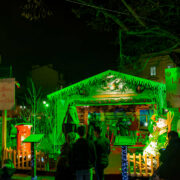
Eglise Collegiale Saint Emilion: a historical jewel
In this guide we would like to tell you about one of New Aquitaine’s most precious treasures: the Eglise Collégiale de Saint Emilion. This magnificent monument is not only a silent witness to the rich history of the region, but also a sublime example of medieval religious architecture.
For those who wish to discover all its secrets and anecdotes, we strongly recommend taking part in a free tour of Saint Emilion. This gives a unique and detailed perspective, taking you through the lesser-known corners of the church and immersing you in its fascinating past.
Why should you visit Saint Emilion?
This is not only a destination for wine lovers, but also a historical and cultural treasure. A must-do experience is a wine tasting in Saint Emilion, where you can sample some of the world’s finest wines. Best of all, you can learn about wine-making in an idyllic setting.
If you don’t know what to see in Saint Emilion, you’ll find there’s actually a wide range of options. From its cobbled streets and limestone buildings to its stunning vineyards, every corner of this village is full of charm and history. Don’t miss the chance to explore the ancient churches (like the one you’re about to see) and catacombs.
Is Saint Emilion worth a visit? The answer is a resounding yes. As we said, not only does it offer you a first-class wine experience, but also the opportunity to immerse yourself in centuries of history and art. The Eglise Collegiale de Saint Emilion, for example, is a wonderful example of religious architecture and a focal point of your visit to this charming village.
In addition, Saint Emilion is one of the most beautiful villages near Bordeaux, making it the ideal starting point for exploring the region. Each village offers its own unique history, exquisite gastronomy and, of course, more opportunities for exceptional wine tasting.
Discovering the Eglise Collegiale Saint Emilion
The Eglise Collégiale de Saint Emilion stands not only as a historical monument, but also as an emblem of the heritage and culture of this famous wine region.
Dating back to the 12th century, this building is not only an example of medieval religious art, but also a symbol of the historical and cultural evolution of Saint-Émilion. Through its stones, stained glass windows and sculptures, it tells the story of a village that has witnessed wars, revolutions and transformations over the centuries.
History and architecture
As we have already mentioned, construction began in the 12th century and continued for several centuries, reflecting the changing artistic and religious currents of the time. Initially erected to house the community of canons of St. Augustine, the church became a symbol of religious and political influence in the region.
The first stone was laid in 1110, and over the centuries, the structure was expanded and embellished, with significant additions in the 13th and 15th centuries. The result is an impressive blend of Romanesque and Gothic styles.
The Collegiate Church’s architecture is a reflection of its rich history. The cupolas on pendentives in the bays of the church are outstanding examples of the southwestern Romanesque style, while most of the elements visible today belong to the Gothic, a transformation that speaks of the stylistic and cultural changes of the time.
Highlights of the Eglise Collegiale Saint-Emilion
The Collegiate Church of Saint-Émilion is home to artistic and religious treasures of great value. Of particular note is the statue of Saint Valéry, the local saint and protector of winegrowers. This 16th century polychrome wooden statue, located near the sacristy door, shows an impressive precision in facial details and clothing.
The cloister, with its wooden galleries and twin columns, is another remarkable element. It dates from the 14th century and forms a square thirty metres on each side. It is not only a place of peace and contemplation, but also a testimony to the art and architecture of the Gothic period, with its decorated capitals and arches that invite reflection and spiritual rest.
The Eglise Collegiale de Saint Emilion attracts not only for its history and architecture, but also for its fascinating artistic features. One of its most impressive features is the high altar, a masterpiece of religious art, adorned with intricate carvings and carved figures, depicting biblical scenes and key moments in Christian history.
Another highlight are the magnificent stained glass windows that adorn the church windows. These works of glass art, some of which date back to the 13th and 14th centuries, illuminate the interior of the church with a colourful and ethereal light. Of course, they also tell stories of Christianity through their complex designs and symbolism.
In addition, the church houses a number of frescoes and wall paintings, many of which have been carefully restored to preserve their original beauty. These offer an insight into the religious art and painting techniques used at different times, and are a key element in the visual and historical narrative of the building.
The current situation of the Collegiate Church of Saint Emilion
Today, the Eglise Collégiale de Saint Emilion remains a vital centre of community and spiritual life. Now serving as the town’s parish church, it not only hosts religious services, but has also become a cultural meeting place.
The Aemilianus Association organises an annual series of concerts within its walls. It offers a unique experience where music merges with history, giving visitors and locals a way to connect with Saint-Émilion’s rich heritage.
Overall, the Eglise Collegiale de Saint Emilion is much more than a building. It is a living compendium of art, history and faith, a place where every stone, every carving and every painting has a story to tell, inviting visitors to immerse themselves in a journey through time and spirituality.



